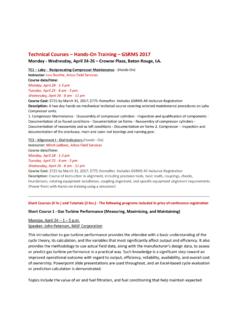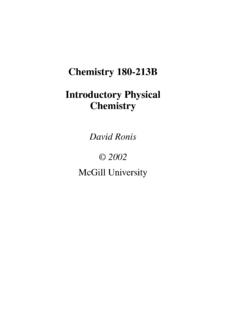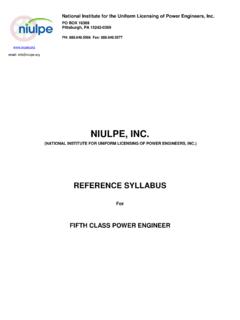Transcription of UNIT 61: ENGINEERING THERMODYNAMICS - FREE …
1 1 unit 61: ENGINEERING THERMODYNAMICS unit code: D/601/1410 QCF level: 5 Credit value: 15 OUTCOME 3 TUTORIAL No. 6 - RECIPROCATING AIR COMPRESSORS 3 Be able to evaluate the performance of reciprocating air compressors Property diagrams: theoretical pressure-volume diagrams for single and multistage compressors; actual indicator diagrams; actual, isothermal and adiabatic compression curves; induction and delivery lines; effects of clearance volume Performance characteristics: free air delivery; volumetric efficiency; actual and isothermal work done per cycle; isothermal efficiency First law of THERMODYNAMICS : input power; air power; heat transfer to intercooler and aftercooler; energy balance Faults and hazards: effects of water in compressed air; causes of compressor fires and explosions In order to complete this section you should be familiar with gas laws and polytropic gas processes.
2 You will study the principles of reciprocating compressors in detail and some principles of rotary compressors. On completion you should be able to do the following. Describe the working principles of reciprocating compressors. Describe the basic design of various other compressors. Define and calculate swept volume. Define and calculate volumetric efficiency. Define and calculate isothermal efficiency. Define and calculate indicated power. State the benefits of cooling. Calculate the heat rejected through cooling. Define and calculate the inter-stage pressures for multiple compressors. 2 INTRODUCTION Air is an expansive substance and dangerous when used at high pressures. For this reason, most applications are confined to things requiring low pressures (10 bar or lower) but there are industrial uses for high pressure air up to 100 bar.
3 The common source of the air is the compressor. There are many types of compressors with different working principles and working conditions. This is a list of the main types. Reciprocating. Sliding vane compressors. Lobe compressors. Helical screws. Centrifugal. Axial turbine compressors. The function of all of them is to draw in air from the atmosphere and produce air at pressures substantially higher. Usually a storage vessel or receiver is used with the compressor. Compressed air has many applications. It is also used for powering pneumatically operated machines. It is used as a power medium for workshop tools such as shown in Fig. 1 1. COMPRESSED AIR ATMOSPHERIC VAPOUR Water vapour in the atmosphere has important consequences on compressors.
4 Atmospheric air contains WATER VAPOUR mixed with the other gases. The ratio of the mass of water vapour in the air to the mass of the air is called the ABSOLUTE HUMIDITY. The quantity of water that can be absorbed into the air at a given pressure depends upon the temperature. The hotter the air, the more water it can absorb. When the air contains the maximum possible amount of vapour it is at its dew point and rain or fog will appear. The air is then said to have 100% humidity. When the air contains no water vapour at all (dry air), it has 0% humidity. This is called the RELATIVE HUMIDITY. For example if the air has 40% relative humidity it means that it contains 40% of the maximum that it could contain. There are various ways to determine the humidity of air and instruments for doing this are called HYGROMETERS.
5 3 The importance of humidity to air compressors is as follows. When air is sucked into the compressor, it brings with it water vapour. When the air is compressed the pressure and the temperature of the air goes up and the result is that the compressed air will have a relative humidity of about 100% and it will be warm. When the air leaves the compressor it will cool down and the water vapour will condense. Water will then clog the compressor, the receiver and the pipes. Water damages air tools; ruins paint sprays, and corrode pipes and equipment. For this reason the water must be removed and the best way is to use a well designed compressor installation and distribution network. TYPICAL RECIPROCATING COMPRESSOR LAYOUT Figure 2 shows the layout of a two stage reciprocating compressor typically for supplying a workshop.
6 1. Induction box and silencer on outside of building with course screen. 2. Induction filter. 3. Low pressure stage. 4. Intercooler. 5. High pressure stage. 6. Silencer. 7. Drain trap. 8. After cooler 9. Pressure gauge. 10. Air receiver. 11. Safety pressure relief valve. 12. Stop valve 4 HAZARDS AND SAFETY Dangers associated with air compressors are as follows. Pressure vessels may rupture. Oil leaks may burn or cause other accidents. Oil in the compressed air may explode. Water in the compressed air may damage equipment. There are many regulations concerning the use, maintenance and inspection of pressure vessels. Vessels must have the safe working pressure marked on them. They must have a pressure gauge and be fitted with an isolating valve. They must also be fitted with a pressure release valve to prevent overpressure.
7 In particular, with reciprocating compressors, if water accumulates in the cylinder, it may fill the space so completely that it prevents the piston reaching the end of its travel and cause damage to the piston and head. Oil in the cylinder can explode during compression. Normally the operating pressure is not high enough to produce the temperature required. However, if the outlet becomes blocked ( the valve sticks or the outlet pipe is closed with an isolating valve), then the danger exists. Oil or water in the air can also cause damage when supplied to some kinds of tools. For this reason a good installation fully conditions the air to remove water, dirt and oil. The following is a list of precautions to be taken against fires and explosions. Avoid overheating. Keep discharge temperatures within the recommended limits.
8 Keep the deposit formation to a minimum by using the correct lubricant. Ensure efficient filtration of the air. This reduces wear on the valves and pistons and reduces deposits of carbonised particles. Avoid over-feeding oil to the cylinders. Minimise the carry over of oil between stages. Avoid high temperatures and low airflow when idling. Keep the coolers in good condition. Do not use solvents for cleaning or use anywhere near to an installation as the vapour given off can ignite. Do not allow naked flames ( smoking) near to an installation when it is opened. 5 FREE AIR DELIVERY When a gas such as air flows in a pipe, the mass of the air depends upon the pressure and temperature. It would be meaningless to talk about the volume of the air unless the pressure and temperature are considered.
9 For this reason the volume of air is usually stated as FREE AIR DELIVERY or FAD. In other words FAD refers to the volume the air would have if let out of the pipe and returned to atmospheric pressure and temperature. The FAD is also the volume of air drawn into a compressor from the atmosphere. After compression and cooling the air is returned to the original temperature but it is at a higher pressure. Suppose atmospheric conditions are paTa and Va (the FAD) and the compressed conditions are p, V and T. Applying the gas law we have .. DAFTppVTVTVpTpVaaaaaa 6 2. CYCLE FOR RECIPROCATING COMPRESSOR THEORETICAL CYCLE Figure 3 shows the basic design of a reciprocating compressor. Fig. 3 Figure 4 shows the pressure volume diagram for an ideal reciprocating compressor. The piston reciprocates drawing in gas, compressing it and expelling it.
10 If the piston expels all the air and there is no restriction at the valves, the pressure - volume cycle is as shown. Gas is induced from 4 to 1 at the inlet pressure. It is then trapped inside the cylinder and compressed according the law pVn = C. At point 2 the pressure reaches the same level as that in the delivery pipe and the outlet valve pops open. Air is then expelled at the delivery pressure. The delivery pressure might rise very slightly during expulsion if the gas is being compacted into a fixed storage volume. This is how pressure builds up from switch on. 7 VOLUMETRIC EFFICIENCY In reality, the piston cannot expel all the gas and a clearance volume is needed between the piston and the cylinder head. This means that a small volume of compressed gas is trapped in the cylinder at point 3.
















